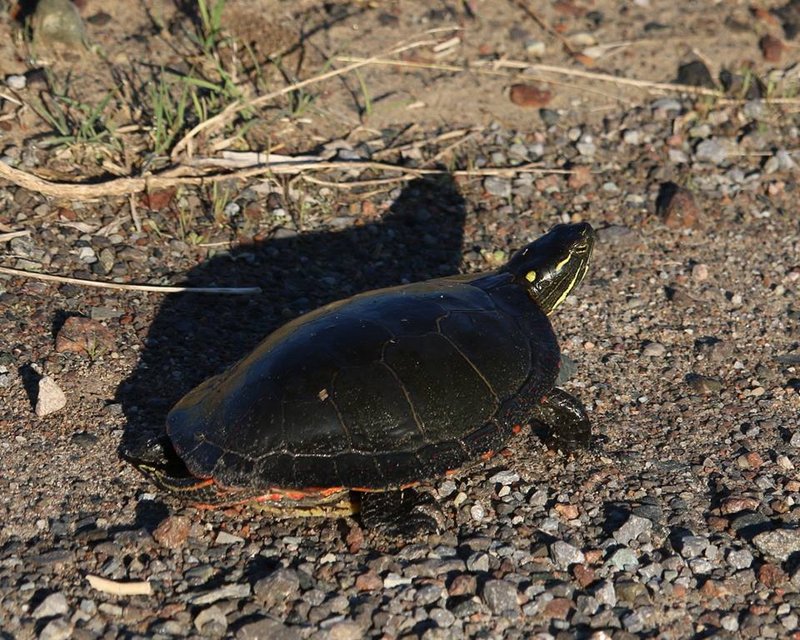
Painted turtles are quite common. You can find them basking on rocks or swimming in ponds across North America. They’re beautiful animals, but like many creatures in nature, they have their own quirks and traits that make them unique. While they’re generally harmless, it’s essential to understand more about them—how they behave, their habits, and, yes, whether they can pose any risk. So let’s explore the painted turtle’s world and see what we can uncover.
What Exactly Is a Painted Turtle?
The painted turtle, scientifically known as *Chrysemys picta*, is one of the most recognizable turtles in North America. These turtles have distinctive patterns on their shells, featuring smooth, bright colors ranging from yellow to red. They’re not just pretty faces; painted turtles are also quite adaptable, found in a variety of habitats from ponds and rivers to swamps.
You might spot them sunbathing on logs or swimming gracefully in the water. They’re known for being social, often seen in groups during the warmer months. Typically, painted turtles grow to be around 5 to 10 inches long, making them relatively small compared to other turtles. Their size and charm make them a favorite among pet owners and nature enthusiasts alike.
Do Painted Turtles Have Any Teeth?
Now, here’s a common question: do painted turtles have teeth? The answer is no, they don’t! Instead of teeth, they have a beak-like mouth that helps them grip and chew their food. This means they can’t bite down like a dog or a crocodile. However, they can still nip if they feel threatened or scared.
Picture this: if you’re trying to pet a painted turtle that’s a bit anxious, it might take a quick swipe with its beak, just as a reaction. While this can be startling, it’s usually more of an “I’m scared!” response than an aggressive one. So, while they lack traditional teeth, their beak can still pinch a bit, especially if they’re provoked.
Are Painted Turtles Venomous or Poisonous?
You might be wondering if painted turtles have any kind of venom or poison. The good news is, they’re not venomous or poisonous at all! This means they can’t harm you through bites or toxins. It’s like being around a particularly colorful rock—beautiful and interesting, but not dangerous.
Turtles, in general, have developed various survival mechanisms, but painted turtles rely more on their shells for protection than any toxic defense. If threatened, they’ll often retreat into their shells or swim away quickly. This behavior is typical among many turtle species, emphasizing their preference for avoiding conflict rather than confrontation.
How Safe Are Painted Turtles as Pets?
If you’re thinking about getting a painted turtle as a pet, that’s a great decision, but there are some things to keep in mind. First, they can live for several decades—some even reach 50 years! So, it’s a long-term commitment. They’re also relatively low-maintenance compared to other pets, but they still require a proper habitat, including a suitable tank, heat sources, and clean water.
However, here’s the thing: while they’re mostly harmless, they can carry bacteria like *Salmonella*. This bacterium can be transmitted to humans, especially if proper hygiene isn’t maintained. Always wash your hands after handling a painted turtle or cleaning its habitat. It’s a simple precaution to keep both you and your new friend safe.
Understanding Their Behavior
You may be curious about what makes painted turtles tick. These animals are known for their calm demeanor, but they can also exhibit some interesting behaviors. For instance, they tend to be more active during the early morning and late afternoon, which means you might see more of them basking as the sun rises and sets.
During mating season, males may chase females or attempt to get their attention by displaying their vibrant colors. While their courtship rituals can be a bit aggressive, they remain safe toward humans, showing only a playful side of their behavior.
What Should You Do If You Encounter a Painted Turtle?
If you spot a painted turtle in the wild, it’s best to appreciate it from a distance. They’re generally shy and prefer not to interact with humans. If you need to help a turtle cross a road, approach it calmly and move it in the direction it’s headed. This helps ensure the turtle’s safety without causing stress.
Remember, painted turtles are protected in many areas, so it’s always good practice to avoid disturbing their natural habitats. Enjoy observing them, but let them live their lives free and happy!
In summary, painted turtles are charming creatures that add beauty to our natural world. They’re not dangerous to humans in any serious way, but like all animals, they should be treated with respect. Understanding their behaviors, habitats, and potential health concerns can help you appreciate these turtles even more.
So whether you’re watching them in a pond, considering adopting one as a pet, or simply enjoying their presence in the wild, it’s clear that painted turtles are fascinating animals worth learning about. Just remember to admire them from a distance, and they’ll happily continue being the colorful residents of our ecosystems.

